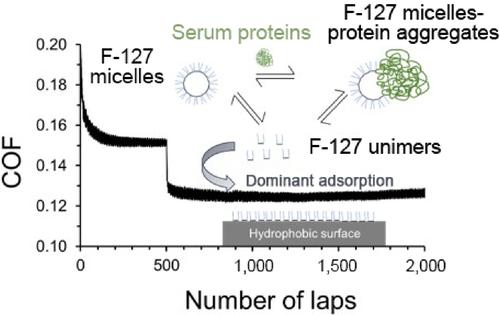Friction ( IF 6.3 ) Pub Date : 2025-5-29 , DOI: 10.26599/frict.2025.9441036
Ruben Del Campo Muga , Seunghwan Lee

|
In this study, we report the feasibility of Pluronic “F-127” as a lubricant for CoCrMo/ultrahigh molecular weight polyethylene (UHMWPE) interface in serum as a synovial fluid (SyF) model. While adsorption and lubrication properties of amphiphilic copolymers such as F-127 at a hydrophobic surface in aqueous media have been well established, its efficacy in serum can be more complicated due to potential interaction of F-127 with serum proteins or competitive adsorption onto UHMWPE surface. When an aliquot of F-127 solution (in concentration range of F-127 from 0.1% to 20% dissolved in 4-(2-hydroxyethyl)-1-piperazineethanesulfonic acid (HEPES)) was added into serum where a CoCrMo pin is sliding against a UHMWPE disk, an immediate decrease in the coefficient of friction (COF) (ca. 20%) was observed. A spectroscopy study employing dynamic light scattering (DLS), circular dichroism (CD) spectroscopy, and ultraviolet (UV) absorbance spectroscopy has shown that serum associatively interacts with F-127 when the F-127 concentration is above critical micelle concentration (CMC), leading to an increase in hydrodynamic size and alteration of tertiary structure of proteins in serum. Mixing of F-127 with the solutions of selected single component biomolecules of serum showed that γ-globulin is the primary molecule that interacts with F-127 above CMC, followed by albumin. Meanwhile, no indication of interaction was observed when the F-127 concentration was below CMC. It is thus proposed that the observed lubricating effect of F-127 in serum is primarily due to the faster surface adsorption kinetics for its smaller molecular weight compared to serum proteins. Further, comparable % reduction in COF over a wide range of F-127 concentration indicates that unimeric F-127 molecules are dominant in contribution to friction-lowering effect even at above CMC at CoCrMo/UHMWPE interface in serum.
中文翻译:

Pluronic F-127 与血清蛋白的相互作用及其作为 CoCrMo/UHMWPE 界面润滑添加剂的可行性
在这项研究中,我们报道了 Pluronic “F-127” 作为血清中 CoCrMo/超高分子量聚乙烯 (UHMWPE) 界面润滑剂作为滑液 (SyF) 模型的可行性。虽然 F-127 等两亲性共聚物在水性介质中疏水表面的吸附和润滑性能已得到充分证实,但由于 F-127 与血清蛋白的潜在相互作用或竞争性吸附到 UHMWPE 表面,其在血清中的功效可能更加复杂。当将等分试样的 F-127 溶液(F-127 浓度范围为 0.1% 至 20% 溶于 4-(2-羟乙基)-1-哌嗪乙磺酸 (HEPES))中加入血清中时,其中 CoCrMo 针在 UHMWPE 盘上滑动,观察到摩擦系数 (COF) 立即降低(约 20%)。一项采用动态光散射 (DLS)、圆二色谱 (CD) 光谱和紫外 (UV) 吸光度光谱的光谱研究表明,当 F-127 浓度高于临界胶束浓度 (CMC) 时,血清与 F-127 结合相互作用,导致液体动力学尺寸增加和血清中蛋白质的三级结构改变。将 F-127 与选定的血清单组分生物分子溶液混合表明,γ-球蛋白是与 CMC 以上的 F-127 相互作用的主要分子,其次是白蛋白。同时,当 F-127 浓度低于 CMC 时,没有观察到相互作用的迹象。因此提出,在血清中观察到的 F-127 润滑作用主要是由于与血清蛋白相比,其较小分子量的表面吸附动力学更快。 此外,在较宽的 F-127 浓度范围内,COF 的相当降低百分比表明,即使在血清中 CoCrMo/UHMWPE 界面处高于 CMC 时,单聚体 F-127 分子在降低摩擦效果方面也占主导地位。


















































 京公网安备 11010802027423号
京公网安备 11010802027423号